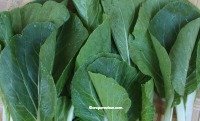Leafy vegetables or vegetable crops are plants that supply edible leaves in various stages of development for culinary use.
The leaves may be separate and fully expanded or form ahead. In some species, the leaves are cooked and attached to segments of succulent stems.
Examples of these vegetables, without specifying geographical adaptation, are provided in the next table.
For clarity, some examples are included even though their primary products are not the leaves.
In such cases, the inclusion is merely to inform that their leaves are likewise commonly utilized in the preparation of vegetable dishes.

List of Leafy Vegetables
Table LV-3. List of leafy vegetables, their common names, scientific names, botanical family, and other relevant information.
| Crop Name | Scientific Name | Family | Collective Name for Members of the Family, Other Info |
| Leafy Vegetables | |||
| Amaranth, kulitis | Amaranthus spinosus | Amaranthaceae | Amaranth family, includes Chenopodiaceae |
| Brussels sprouts | Brassica oleracea, Gemmifera group | Brassicaceae/Cruciferae | Mustard family, also called Cole Crops and Crucifers; referred to as miniature cabbage |
| Cabbage | Brassica oleracea, Capitata group | Brassicaceae/Cruciferae | Mustard family, also called Cole Crops and Crucifers |
| Celery | Apium graveolens | Apiaceae/Umbelliferae | Carrot family |
| Charantia, bitter melon, bitter gourd, ampalaya | Momordica charantia | Cucurbitaceae | Cucumber/Gourd family, cucurbits; primarily grown as fruit vegetable but the leaves and young stems (tops) are also eaten blanched or as ingredient in many vegetable dishes. |
| Chard, Swiss chard, leaf beet | Beta vulgaris var. cicla | Amaranthaceae | Amaranth family, includes Chenopodiaceae |
| Chicory | Cichorium intybus | Asteraceae/Compositae | Sunflower family |
| Chili pepper, hot pepper, siling-labuyo | Capsicum frutescens | Solanaceae | Nightshade family, also called Solanaceous crops; the fruits are widely used as a spice but the leaves are also cooked as a vegetable |
| Chinese cabbage | Brassica rapa var. pekinensis | Brassicaceae/Cruciferae | Mustard family, also called Cole Crops and Crucifers |
| Endive | Cichorium endivia | Brassicaceae/Cruciferae | Mustard family, also called Cole Crops and Crucifers |
| Garden cress, peppercress | Lepidium sativum | Brassicaceae/Cruciferae | Mustard family, also called Cole Crops and Crucifers |
| Jew’s mallow, red jute, saluyot | Corchorus olitorius | Malvaceae | Mallow family |
| Kale | Brassica oleracea, Acephala group | Brassicaceae/Cruciferae | Mustard family, also called Cole Crops and Crucifers |
| Lettuce | Lactuca sativa | Asteraceae/Compositae | Sunflower family |
| Moringa, malunggay | Moringa oleifera | Moringaceae | Green pods and the flowers are also cooked as ingredient of some vegetable dishes. |
| Malabar nightshade, alugbate | Basella rubra | Basellaceae | a coiling vine; young leaves are eaten as cooked vegetable including succulent stems |
| Mustard green, Oriental mustard, mustasa | Brassica juncea | Brassicaceae/Cruciferae | Mustard family, also called Cole Crops and Crucifers |
| Pak choi, pechay | Brassica rapa var. chinensis | Brassicaceae/Cruciferae | Mustard family, also called Cole Crops and Crucifers |
| Rhubarb | Rheum rhaponticum | Polygonaceae | Buckwheat family |
| Spinach | Spinacea oleracea | Apiaceae/Umbelliferae | Carrot family |
| Sweet potato (camote tops) | Ipomoaea batatas | Convolvulaceae | Morning Glory/Bindweed family; Sweet potato is generally classified as a starchy root crop (under root and tuber crops) but some varieties are grown for the production of camote tops which consist of young leaves and a portion of the stem including the tips. |
| Taro, dasheen, gabi | Colocasia esculenta | Araceae | Arum family; taro is generally classified as a starchy corm crop (under root and tuber crops) but some varieties are grown for their leaves and petioles (as well as stolons). One has pinkish leaves and petioles and is called “abalong” in some localities in the Philippines. Corms are small. |
| Vegetable fern, pako | Diplazium esculentum syn. Athyrium esculentum | Dryopteridaceae | Dryopteroid family |
REFERENCES
- HILL A. 1972. Economic Botany. 2nd ed. New Delhi: Tata McGraw-Hill Publishing Co. Ltd. 560 p.
- MERRILL E. 1912. Flora of Manila. Manila: Bureau of Printing. 491 p.
- PEEL L. 2004. HarperCollins Practical Gardener: Kitchen Garden. New York, NY: HarperCollins Publishers Inc. 176 p.
- SIMPSON MG. 2010. Plant Systematics. 2nd ed. San Diego, CA: Elsevier Inc. 740 p.
- The Essential Gardening Encyclopedia. 2003. San Francisco, CA: Fog City Press. 608 p.
